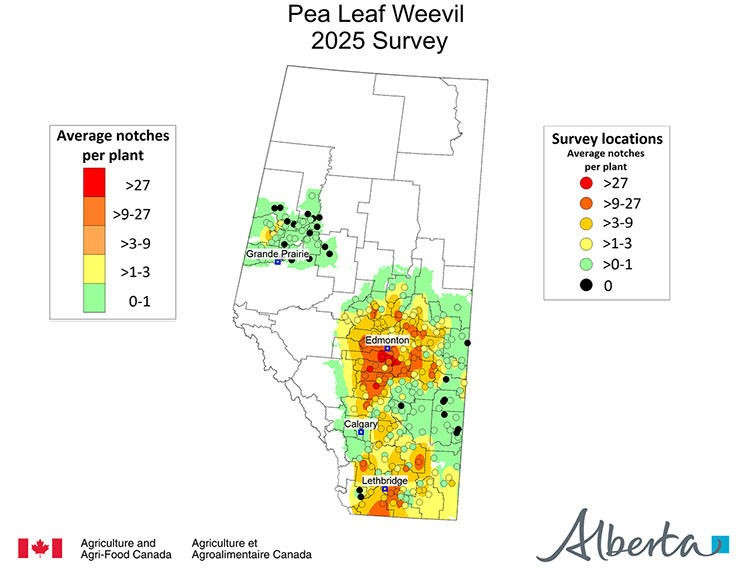Non-urgent government operations are closed December 24 to January 1, reopening January 2. View available services during this period.
This is not a forecast. It is a summary of the pea leaf weevil situation in Alberta in spring 2025.
Methodology
The pea leaf weevil (Sitona lineatus) survey was completed in late May and early June 2025. It is based on damage ratings in 244 fields from 59 municipalities.
In each field, the total number of feeding notches per plant were counted on 10 plants in 5 locations near the field edge for a total of 50 plants. The damage rating for a particular field is the average number of notches per plant. This survey concentrates on damage done by the adult, but yield losses are caused by the larval damage to the nitrogen fixing root nodules.
2025 survey findings
The circles on the map show the general area where the monitoring took place. In 2025, there was an increase in the number of notches found compared to 2024. Higher rates of notching were found in central Alberta along the highway 2 corridor and in hotspots in southern Alberta.
We do know that pea leaf weevil is in the Peace region, and in 2025, survey technicians found moderately higher feeding damage with one hotspot in Saddle Hills.
The relationships between pea leaf weevil notching, population density, and economic damage depend on weather and agronomic factors. This survey provides an estimate of adult weevil populations in the spring, which does not always translate into economic damage by larvae. Central Alberta received plenty of rainfall in 2025, which may have allowed the crop to compensate for pea leaf weevil damage.
Producers should use their own experience with the information generated from this survey, to plan control strategies such as seed treatment for the 2026 crop year. Research has shown that preventative seed treatments are more effective than foliar treatments. Foliar treatments do not prevent yield losses from pea leaf weevil. Seedlings will recover from feeding damage, except in very severe cases.
Spring weather conditions
Higher yield impacts are likely when weevils arrive in smaller pea crops and much less likely when the crop is advanced past the 6-node stage. Weather conditions, as well as seeding dates, will impact this. When warm conditions (greater than 20C) persist for more than a few days in late April or early May, the weevils arrive in fields early. In years where cool weather persists, PLW’s arrival can be much later, and the resulting yield impact is lower. In every case, control decisions should be made on a field-by-field basis.
Since 2014, significant pea leaf weevil damage has been seen on faba beans in a much larger area than shown in this survey that is conducted on field peas. This insect causes as much or more damage on faba beans.
Find out more about the pea leaf weevil life cycle.
Acknowledgements
The 2025 survey was completed by Agriculture and Irrigation, Plant and Bee Health Surveillance Section staff. Thank you to Alberta Plant Health Lab Survey Technicians for their contribution to the survey.
Thank you to all the agronomists and Agriculture Fieldmen who lined up fields and to the producers who offered their fields for the survey.
Thanks to Jon Williams, Agriculture and Agri-Food Canada, Saskatoon, for preparing the map.
